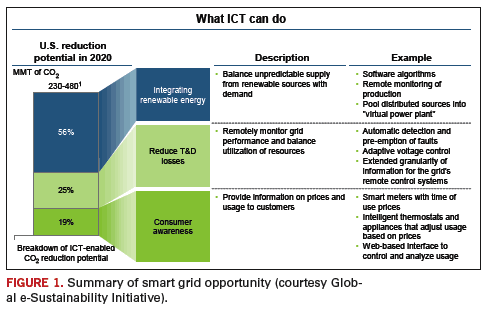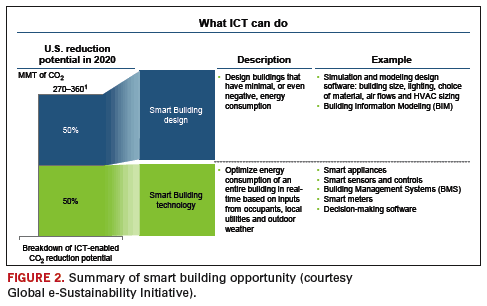
Our collective industry holds potential for far-reaching energy-efficient impacts.
Over the past several years, environmental sustainability has evolved into a more refined technical discipline. The imperative is clear: We, as global citizens and industry leaders, have an incumbent responsibility and opportunity to minimize the environmental impact from our operations, products and services.
To date, most “environmental” initiatives within the electronics industry have focused primarily on the potential pollutants that might occur as a result of manufacturing processes or end-of-life disposal of products. As a result, efforts have centered on elimination of substances (most notably, lead), along with recycling/reuse and take-back, much of which has been driven by legislative requirements. In addition, individual firms have focused on energy efficiency to make their products more competitive.
There is, however, another — more significant — aspect, and that is the electronics industry as a solution for climate change. While there is the responsibility to minimize the environmental impact from operations, products and services, the compelling news is that the industry has a particular opportunity to use its products and services to help society function more efficiently and easily, while consuming less material and energy resources.
A recent article in The Economist1 references a GeSI (Global e-Sustainability Initiative) report, saying “the savings made possible by computing’s ‘enabling effects’ could amount to five times computing’s own footprint.” Another report predicts that electronics-enabled solutions could cut annual CO2 emissions in the U.S. by 13% to 22% from business-as-usual projections for 2020. This translates to gross energy and fuel savings of $140 billion to $240 billion.2
Between 1990 and 2007, the economic output of the European Union grew almost 40%, and its per capita incomes by more than a third.3 Yet, its energy requirements and power consumption, while rising, did so by only 11%. This “decoupling,” as it has been called, of economic growth and energy use, shows that today, more can be done with each unit of energy consumed. Statistics from the US show a similar trend: The amount of energy needed to produce a dollar of economic output has fallen by 50% since 1970.4 If productivity can rise without a similar increase in energy consumption, then an environmentally sustainable, low-carbon economy is realistically achievable.
The electronics industry is in a unique position to demonstrate leadership in reducing its own footprint by creating energy efficient solutions5 for other sectors through structural change and innovation.
Structural change is the contribution by the industry to re-engineer the way organizations operate. Replacing products with online services (e.g., newsletters), moving business to the Internet (e.g., customer support) and adopting technology-enabled ways of working (e.g., telecommuting, videoconferencing) are great first examples of the changes the industry can produce.
In terms of innovation, research has been done to improve energy efficiency of components, subsystems and full products. A prime example is the efficiency gains of displays. Replacing CRTs (cathode-ray tubes) with LCDs (liquid crystal displays) is a massive energy-saving opportunity. The potential for savings is even greater with the advancement of new technologies, such as LEDs (light-emitting diodes) and OLEDs (organic light-emitting diodes). Harnessing the power of innovation in the industry to reduce energy intensity will be key to a minimized footprint of products and businesses.
Influencing Other Sectors
The electronics industry has significant potential to enable reduction of energy consumption in other sectors of the economy. Adding intelligence to systems (e.g., cars, plants) through embedded components will make it possible to improve energy efficiency of operations in very different areas.
The initial focus should be on creating “smart” power grids, buildings and even lights, because of their importance with regard to energy use and the potential for improvement. Other sectors that deserve attention are manufacturing and transport. In the EU, the potential for saving energy in manufacturing and transport is expected to be an estimated 25% and 26%, respectively, of the total primary energy consumption by 2020.
Smart power grids. Improving the power grid is an urgent need, as around one-third of all primary energy is used to generate electricity (Figure 1). There is a huge potential for improving electricity generation by improving transformation efficiency (estimated at 30% to 40% in the EU), as well as addressing the losses in transport (2%) and distribution (8%).6

The industry can contribute here, not only by helping to reduce loss and increase efficiency, but also by supporting the management and control of the distributed power grid. The proliferation of local energy networks, integration of renewable energy sources, increasing use of co- and micro-generation and new user demands make it necessary to adopt the most advanced technologies available for monitoring and control, as well as for electronic trading of electricity.
Smart grids, which are only possible with the support of electronics, can help cut greenhouse gas emissions. They also are needed to readily integrate renewable energy sources like wind and solar power, and to offer consumers the option to reduce their own carbon footprints.7
The SMART 2020/United States Report Addendum indicates that smart grids have the potential to achieve significant CO2 reductions. An estimated 56% of these reductions are expected to be accomplished by integrating renewable energy, 25% by reducing transport and distribution losses and 19% by providing customers with information on prices and use.
Smart buildings. Of the total energy consumption in Europe, more than 40% is related to buildings, be it residential, public, commercial or industrial. European projections indicate considerable energy savings can be expected – up to 27% in residential and 30% in commercial buildings.6 In the US, it is estimated smart building technology will account for approximately 50% of the CO2 reduction potential.
Introducing advanced, flexible and integrated electronics for energy management in old and new buildings will help reduce energy consumption (Figure 2). Smart metering and other smart systems can gather data on the status of a building and the operation of the equipment, which can be fed into a control system to optimize energy performance. When coupled with better insulation and increased control of natural light, these solutions will affect significant reductions.

Smart lighting. Approximately 20% of the world’s electricity consumption is used for lighting, making it a natural target for improving efficiency. The use of LEDs, which are highly efficient and already commercially available, can save up to 30% by 2015 and up to 50% by 2025.5 Integrating sensing capabilities to make lighting adjust to natural light and people’s presence promises even further improvements.
OLED is another technology – currently under development – that promises significant potential. In addition to the fact that the technology is very energy efficient and environmentally safe, this type of lighting can also be made on flexible materials, which opens up a wide range of new options.
Other smart technologies. The recent SMART 20208 report, developed by The Climate Group on behalf of GeSI, identifies additional opportunities for electronics-enabled smart technologies. Among them are smart motor controllers, which could save up to 200 million metric tons (MT) of CO2e. Another example is smart logistics, which offer the opportunity to increase efficiencies in transport and storage, thus delivering fuel, electricity and heating savings of up to 225 MtCO2e.
When talking about sustainability, we are primarily referring to our ability to use our planet’s resources wisely, so future generations can live their lives and enjoy the benefits of our products without concern of degrading the environment or depleting critical resources. While perfection may never be achieved (i.e., zero impact on natural resources and the environment), the concept of sustainability gives the industry a way to think about how it operates and what it can do to minimize the environmental impact. The challenges and opportunities for the industry are significant and go beyond the boundaries we traditionally think about. PCD&F
References
- Tom Standage, “More Silicon, Less Carbon,” The Economist, Nov. 18, 2008.
- GeSI and The Boston Consulting Group, “SMART 2020: Enabling the Low Carbon Economy in the Information Age/United States Report Addendum,” November 2008.
- Advanced Electronics and Information Technologies: The Innovation-Led Climate Change Solution, AeA Europe, September 2007.
- Information and Communication Technologies: The Power of Productivity, American Council for an Energy-Efficient Economy, February 2008.
- Commission of the European Communities, “Addressing the Challenge of Energy Efficiency through Information and Communication Technologies,” May 2008.
- Commission of the European Communities, “Action Plan for Energy Efficiency: Realising the Potential,” October 2006.
Galvin Power, galvinpower.
- The Climate Group on behalf of GeSI, “SMART 2020: Enabling the Low Carbon Economy in the Information Age,” June 2008.
Markus Stutz is EMEA (Europe, Middle East, Africa) environmental affairs manager at Dell (dell.com) and Sustainability Team Leader for the Environmentally Conscious Electronics chapter of the 2009 iNEMI Roadmap; This email address is being protected from spambots. You need JavaScript enabled to view it.. Robert C. Pfahl, Jr. is vice president, global operations, at iNEMI; This email address is being protected from spambots. You need JavaScript enabled to view it..
















